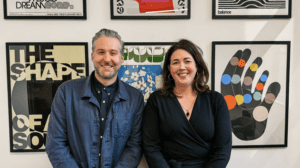Beginning, middle, and end. Even the best stories are designed to end. A company needs constant, consistent relevancy that builds a community over long spans of time. An ad, an execution, even a global fully-integrated Super Bowl campaign doesn’t automatically do that. It’s a story. By contrast, worldbuilding creates a roadmap, lays out guideposts, and establishes a clear set of rules that a brand gets to play in while welcoming audiences to participate.
A thoughtful brand becomes the setting where many stories can take place. Ones told by us, and ones lived by our community. This is how passionate fandoms are built. This is how an ad and a campaign work to create something bigger, and more lasting in the zeitgeist.
What I’m trying to say is, let’s have some fun playing god. Building an entire realized universe where our people want to live and play alongside us. Brand worlds need a cohesive structure and flexibility to adapt to a constantly evolving cultural and technological landscape. Here are a few starting points for building your brand’s universe.

Start Where You Are Today, Not Where You Want To Be
Goals and aspiration thinking are essential. Here, they can hide important truths. Any brand that wants to last has to be built around truth. So start by brainstorming the attributes that make your company special. Keep corporate jargon and money out of it. Everyone wants to be rich and famous. Why was this business actually founded? What does it do for the world? What doesn’t it do? What do your employees think of the business? What do the customers like most and least? What emotional benefits does your offering incite? What other kinds of products, outside of your industry, elicit these same emotions?
It’s not easy. It’s not supposed to be. If you want to make a dent in this world, start getting comfortable being uncomfortable. When you land on a few simple core truths, you now have a foundation of where, how, and why the brand has credibility. Now build on it.
Build While You Grow
The whole point of worldbuilding is creating a larger set of rules that everything inside follows. So as you approach each decision, you now have a framework to check against. Does this campaign build on this? Is our R+D pursuing R+D that will make this true? How can my world and this other brand world come together? What has our community built within this framework?
This is where things like planning, communication goals, business design, all start to have a generative effect. When done right, short-term and long-term goals are the same. The business strategy and creative strategy are the same. Each individual story, our or our community’s, occupies a space within our world. When stories build the brand’s world, the brand builds itself.
The Simpsons is a household name. What started as an animated short became a series that became a powerhouse of immersive storytelling through movies, theme parks, toys, video games, fashion, music, art, literature, language and more. Each touchpoint was a single story moment. What made it last was how they came together. The world that Springfield exists within gives us the collective context we need to tie this story to the last & the next. Progressive worldbuilding through consistent storytelling.

Every Opportunity is a Worldbuilding Opportunity.
Campaigns, activations, packaging, posts, commercials, livestreams, distribution channels, corporate training, employee benefits, OOH, experiential, social, everything you do inside and out is an opportunity to build your brand’s world.
As the world becomes increasingly more connected and people demand more transparency, every single thing you do is social. This is the definition of what we mean when we say “social-out thinking.” It’s why we approach everything we do with brand partners, from influencer marketing campaigns to product development to org design to global launches the exact same. We ask how this builds the larger narrative world. If it builds that, then it builds social influence.
When you think of the most successful businesses in the world, the word ‘consistency’ comes to mind. Nike is Nike everywhere you meet them. On social, on packaging, in an app, in a partnership, in an experience, at their campus, all the way down to the receipts. Everything they’ve done for decades builds a world where today ‘Just Do It’ is cultural shorthand, the swoosh logo is one that athletes of literally every level have a connection to. My 5 and 2 year olds call it out. Imagine where they’re going to take their money when they buy their own shoes. This is where worldbuilding done right can take you.
Make Tools, Not Ads
People don’t buy brands, they buy in. That means cultivating community in a very specific way. The world you build must provide multiple ways for people to contribute, participate, and benefit.
Rethink your goals, we aren’t just telling people stories. We’re arming them with the tools they need to tell their own. So ask how this ad does that. How does this commercial, OOH, experience, activation, campaign, post, program, thing arm the people I’ve brought into this world?
That’s how an ad is so much more than an ad. You’re trading customers & community for champions. The people who join your world and bring their own following. This is what you see when worldbuilding is done right in pop culture. Look around Comic-Con. People don’t build a lifestyle around a one-off. They go deep into the world, the lore, the characters, the imagination it unlocks. They make their own fanfic of the stories they experience. They leap to any chance that allows them to authentically immerse themselves within that world they care about.
This is the goal. Storytelling as most people think of it is small. But done right, stories build entire realities worth escaping into. What will your next story build?






